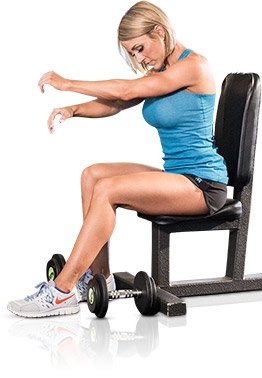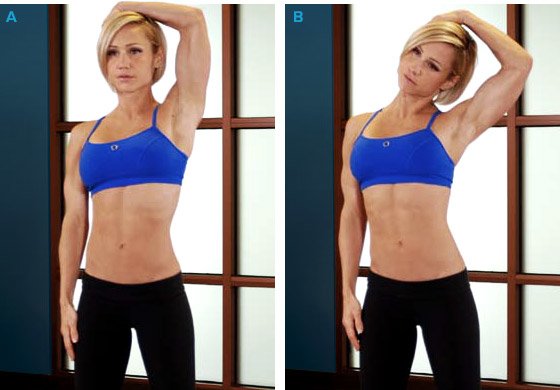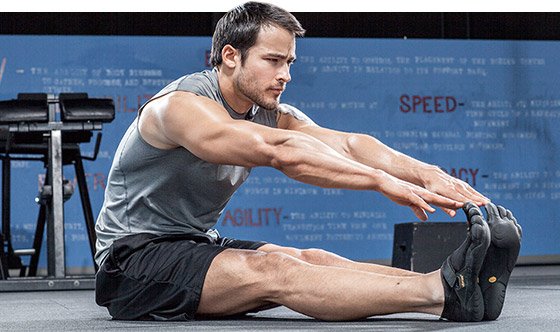
Dynamic stretching, according to Kurz, "involves moving parts of your body and gradually increasing reach, speed of movement, or both." Do not confuse dynamic stretching with ballistic stretching!
Dynamic stretching consists of controlled leg and arm swings that take you (gently!) to the limits of your range of motion. Ballistic stretches involve trying to force a part of the body beyond its range of motion.
In dynamic stretches, there are no bounces or "jerky" movements. An example of dynamic stretching would be slow, controlled leg swings, arm swings, or torso twists.
According to Kurz, dynamic stretching exercises should be performed in sets of 8-20 repetitions. Be sure to stop when and if you feel tired. Tired muscles have less elasticity which decreases the range of motion used in your movements.
Continuing to exercise when you are tired serves only to reset the nervous control of your muscle length at the reduced range of motion used in the exercise (and will cause a loss of flexibility). Once you attain a maximal range of motion for a joint in any direction you should stop doing that movement during that workout.
Tired and overworked muscles won't attain a full range of motion and the muscle's kinesthetic memory will remember the repeated shorted range of motion, which you will then have to overcome before you can make further progress.
The Exercises
Joint Rotations
From a standing position with your arms hanging loosely at you sides, flex, extend, and rotate each of the following joints:
- Fingers
- Wrist
- Elbows
- Shoulders
- Neck
- Trunk and shoulder blades
- Hips
- Knees
- Ankles
- Feet and toes
Neck Mobility
- Flexion/Extension: Tuck your chin into your chest, and then lift your chin upward as far as possible. 6-to-10 repetitions
- Lateral Flexion: lower your left ear toward your left shoulder and then your right ear to your right shoulder. 6-to-10 repetitions
- Rotation: Turn your chin laterally toward your left shoulder and then rotate it toward your right shoulder. 6-to-10 repetitions

Neck Bend
Shoulder Circles
- Stand tall, feet slightly wider than shoulder-width apart, knees slightly bent
- Raise your right shoulder towards your right ear, take it backwards, down and then up again to the ear in a smooth action
- Repeat with the other shoulder
Arm Swings
- Stand tall, feet slightly wider than shoulder-width apart, knees slightly bent
- Keep the back straight at all times
- Overhead/Down and back: Swing both arms continuously to an overhead position and then forward, down, and backwards. 6-to-10 repetitions
- Side/Front Crossover: Swing both arms out to your sides and then cross them in front of your chest. 6-to-10 repetitions
Side Bends

Side Bend
- Stand tall with good posture, feet slightly wider than shoulder-width apart, knees slightly bent, hands resting on hips
- Lift your trunk up and away from your hips and bend smoothly first to one side, then the other, avoiding the tendency to lean either forwards or backwards
- Repeat the whole sequence sixteen times with a slow rhythm, breathing out as you bend to the side, and in as you return to the centre
Hip circles and twists
- Circles: With your hands on your hips and feet spread wider than your shoulders, make circles with your hips in a clockwise direction for 10-to-12 repetitions. Then repeat in a counter clockwise direction
- Twists: Extend your arms out to your sides, and twist your torso and hips to the left, shifting your weight on to the left foot. Then twist your torso to the right while shifting your weight to the right foot. 10-to-12 reps on each side
Half Squat
- Stand tall with good posture holding your hands out in front of you for balance
- Now bend at the knees until your thighs are parallel with the floor
- Keep your back long throughout the movement, and look straight ahead
- Make sure that your knees always point in the same direction as your toes
- Once at your lowest point, fully straighten your legs to return to your starting position
- Repeat the exercise sixteen times with a smooth, controlled rhythm
- Breath in as you descend, and out as you rise
Leg Swings
- Flexion/Extension: Stand sideways onto the wall
- Weight on your left leg and your right hand on the wall for balance
- Swing your right leg forward and backward
- 10-to-12 repetitions on each leg
- Cross-Body flexion/Abduction: Leaning slightly forward with both hands on a wall and your weight on your left leg, swing your right leg to the left in front of your body, pointing your toes upwards as your foot reaches its furthest point of motion
- Then swing the right leg back to the right as far as comfortable, again pointing your toes up as your foot reaches its final point of movement
- 10-to-12 repetitions on each leg
Lunges

"The right thigh should be parallel with the ground and the right lower leg vertical."
- Standing tall both feet together (starting position)
- Keeping the back straight lunge forward with the right leg approx 1-to-1.
- The right thigh should be parallel with the ground and the right lower leg vertical
- Spring back to the starting position
- Repeat with the left leg
- 12-to-16 repetitions on each leg
Ankle Bounce
- Double leg bounce: Leaning forward with your hands on the wall and your weight on your toes, raise and lower both heels rapidly (bounce)
- Each time, lift your heels one to two inches from the ground while maintaining ground contact with the ball of your feet
- 12-to-16 repetitions
- Single leg bounce: leaning forward with your hands on a wall and all your weight on your left foot, raise the right knee forward while pushing the left heel towards the ground
- Then lower the right foot to the floor while raising the left heel one or two inches
- Repeat in a rapid, bouncy fashion
- 12-to-16 repetitions on each leg
This can also be done during the lifts. So in between do squats stretch the quads etc in the rest time of the stretch.
Static Stretching
Many people use the term "passive stretching" and "static stretching" interchangeably. However, there are a number of people who make a distinction between the two.

"Static stretching consists of stretching a muscle (or group of muscles) to its farthest point and then maintaining or holding that position."
According to M. Alter, Static stretching consists of stretching a muscle (or group of muscles) to its farthest point and then maintaining or holding that position, whereas Passive stretching consists of a relaxed person who is relaxed (passive) while some external force (either a person or an apparatus) brings the joint through its range of motion.
Notice that the definition of passive stretching given in the previous section encompasses both of the above definitions. Throughout this document, when the term static stretching or passive stretching is used, its intended meaning is the definition of passive stretching as described in the previous section. You should be aware of these alternative meanings, however, when looking at other references on stretching.
Stretch Routine
All right, you all know how important stretching is so I thought i'd write down my stretching routine for you all, it's not the greatest I takes some times but you can mess with the duration of the exercises but you can get it all done in 3-5 min if you do it back to back
- It's a post workout routine
- I do not add it with the 40-50 min I train it's separate
If you train chest/tri's: I stretch chest with first stretch exercise, then tri's with first, then chest with second and then tri's with second then i'm done it takes about 1 min maybe 2 min at most so I don't think you will be bothered with time here it is:
Quadriceps
- Standing quadriceps stretch (10 seconds)—continue to next stretch
- Lying quadriceps stretch (15 second)—end or continue to next stretch
Hamstrings
- Standing hamstring stretch (10 seconds)—continue to next stretch
- Seated forward hamstring stretch (15 seconds)—end or continue to next stretch
Calves
- Floor board straight leg calf stretch (10 seconds)—continue to next stretch
- Seated barbell calve stretches (15 seconds)—end of continue to next stretch
Back (lats)
- Wall lats stretch (10 seconds)—continue to next stretch
- Flat barbell pull-over in stretched position (15 seconds)—end or continue to next stretch
Back (traps)
- Behind-the-back shrug in stretched position (10 seconds)—end or continue to next stretch
Biceps
- One-arm doorway biceps stretch (10 seconds)—continue to next stretch
- Incline dumbbell curl in stretched position (15 seconds)—end or continue to next stretch
Chest
- Two-arm doorway chest stretch (10 seconds)—continue to next stretch
- Incline/flat dumbbell fly in stretched position (15 seconds)—end or continue to next stretch
Triceps
- Overhead triceps stretch (10 seconds)—continue to next stretch
- Old school triceps stretch (15 seconds)—end or continue to next stretch
Shoulders (font delt)
- Doorway front deltoid stretch (10 seconds)—continue to next stretch
- Incline front deltoid stretch (15 seconds)—end or continue to next stretch
Shoulders (medial delts)
- Side deltoid stretch cross chest (10 seconds)—continue to next stretch
- Behind-the-back side deltoid stretch (15 seconds)—end or continue to next stretch
Forearms
- Barbell wrist curl in stretched position (10 seconds)—end or continue to next stretch
Now pain is normal when you doing this, but if it's a ongoing pain stop doing this and find yourself another stretching routine, it would be stupid to injure yourself with stretching.



